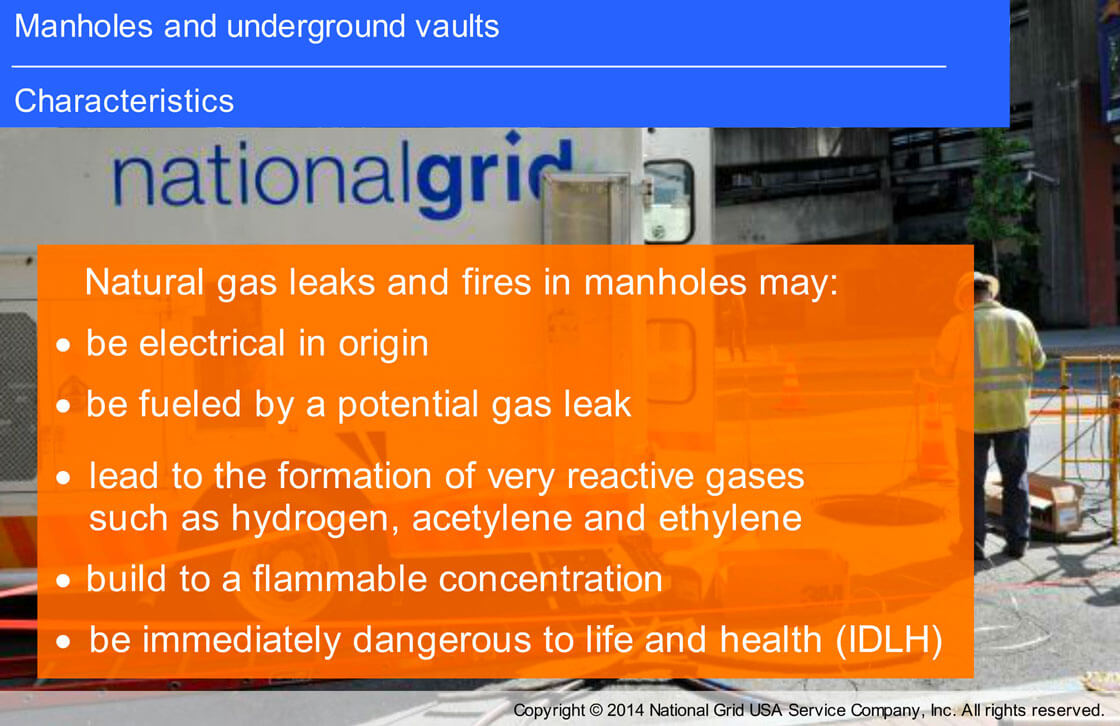 |
 |
|
Manhole incidents: Your key response strategies
|
|
Manhole fires and explosions may be fueled by natural gas leaks or flammable vapors that migrate through underground utility conduits. Leaking gas can quickly build to a flammable concentration within these confined areas, and when ignited, may explode or burn. These incidents may place firefighters in proximity to underground utility lines that are compromised by fire conditions and atmospheres that are immediately dangerous to life and health (IDLH).
|
|
First and foremost: Do not enter!
|
|
Manhole fires may involve utility equipment and lead to the formation of reactive gases such as hydrogen, acetylene and ethylene. Regardless of its size, consider every manhole a confined space containing potentially toxic gases, hazardous materials and an explosive atmosphere, and STAY OUT. |
 |
|
|
Treat a combustible gas fire in a manhole as you would a natural gas fire: Let it burn and protect exposures while you wait for National Grid to arrive and shut off the gas and/or isolate the electric circuit. National Grid representatives can provide valuable situational awareness including the probable location and any hazards present in the manhole.
|
| |
|
|
|
If you must enter a manhole to assist a victim, proceed according to your department’s standard operating procedures for confined space rescue. Use full PPE and SCBA and consider activating special resources such as a technical rescue team.
|
|
| Manhole incident do’s and don’ts |
| • |
|
Check for flammable gas when responding to gas incidents in or around manholes. Always check for flammable gas concentrations, regardless of source, to identify the level of hazard and to identify appropriate evacuation zones.
|
|
|
|
|
| • |
|
Do not remove manhole covers. If a flammable atmosphere exists, opening the cover could bring the atmosphere into the explosive range.
|
|
| • |
|
Never park over or near a manhole cover. An explosion in a manhole can propel the cover into the air with great force. If you detect combustible gas at flammable concentrations near a manhole, keep fire personnel and vehicles away, reroute traffic and evacuate the area.
|
|
| • |
|
Work with National Grid to assess the extent of potential gas migration. Take necessary steps to isolate the affected areas and evacuate potentially impacted structures.
|
|
| • |
|
Be alert for risks posed to nearby plastic gas pipes or cast iron mains. Underground fires or releases of high-pressure steam may compromise these pipes. In either case, combustible gas may accumulate underground at flammable concentrations. Collaborate with National Grid emergency representatives to identify areas served by plastic pipes and cast iron mains.
|
|
|
|
| Case in point: |
| Smoking manhole holds hidden hazard |
Firefighters responding to a call found smoke issuing from a manhole cover in the middle of an intersection in an urban area. In an effort to better determine the source and direction of the smoke, the captain advised the crew to remove the manhole cover and ordered a firefighter to lower a roof ladder into the hole.
Fortunately, utility personnel arrived shortly thereafter and advised the captain that the underground area was a power vault containing high-voltage equipment. This incident provided a lesson in situational awareness. The captain failed to identify the power vault and exposed the crew to unnecessary danger.
Operations at this incident should have been confined to creating an exclusion zone and awaiting the arrival of the utility company.
|
|
|
|
Learn more gas and electrical utility response tips at firstresponder.ngridsafety.com.
|
|
National Grid’s free First Responder Utility Safety Training Program has helped thousands of emergency response personnel learn to operate safely during incidents involving utility hazards. This program, which includes gas and electric certification trainings, covers natural gas pipelines and electric power lines as well as other facilities.
|
 |
|
Through this training, you will gain the knowledge, skills and technical ability required to respond to the most common electrical and natural gas emergencies.
|
|
Our certification programs are self-paced. Users who complete the gas and electric programs will earn personalized certificates of completion.
|
|
|
| Keep yourself, your team and the public safe. Visit firstresponder.ngridsafety.com today to register and complete your utility safety training. |
|
|
| To report emergencies, call 911 and National Grid immediately. |
|
| In case of gas emergencies: |
| Long Island and the Rockaways: |
|
|
|
|
|
|
|
|
|
|
|
| In case of electric emergencies: |
| Upstate New York: |
|
|
|
|
|
|
|
|
|
|
|
|
 |
| #11972 |
|
|